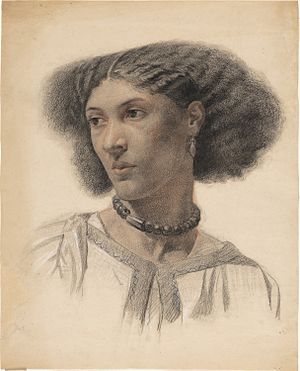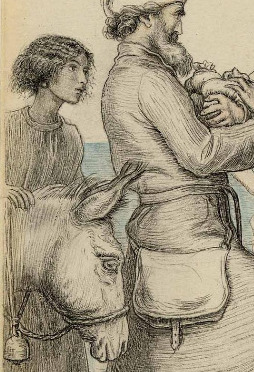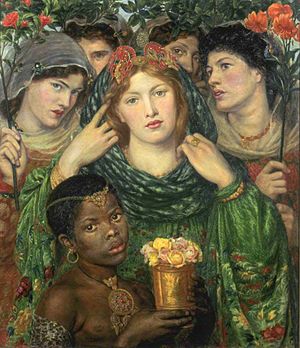Fanny Eaton facts for kids
Quick facts for kids
Fanny Eaton
|
|
|---|---|

Portrait of Mrs. Fanny Eaton (1859), Walter Fryer Stocks
|
|
| Born |
Fanny Antwistle
23 June 1835 |
| Died | 4 March 1924 (aged 88) Hammersmith and Fulham, London, England
|
| Nationality | Jamaican, British |
| Occupation | Art model, domestic cook |
| Years active | 1859–1867 (art model) |
| Known for | Pre-Raphaelite model |
Fanny Eaton (born June 23, 1835 – died March 4, 1924) was an Jamaican-born artist's model and a domestic worker. She is famous for posing for the Pre-Raphaelite Brotherhood and their friends in England. She modeled for them between 1859 and 1867.
Her first public appearance as a model was in Simeon Solomon's painting The Mother of Moses. This painting was shown at the Royal Academy in 1860. Many other artists also featured her in their works. These artists included Dante Gabriel Rossetti, John Everett Millais, Joanna Mary Boyce, and Rebecca Solomon.
Contents
Her Life Story
Early Years
Fanny Eaton was born Fanny Antwistle on June 23, 1835, in Saint Andrew Parish, Jamaica. This was just ten months after slavery was ended in the British Empire. Her mother, Matilda Foster, was of African descent.
Fanny and her mother moved to England sometime in the 1840s. By 1851, she was living in London and working as a domestic servant. In 1857, she married James Eaton. He was a horse-cab driver. They had ten children together between 1858 and 1879.
Her Time as a Model
Fanny Eaton began modeling while she was a young wife and mother. She modeled for the Royal Academy of Arts School of Painting. She also worked for the Pre-Raphaelites and other artists. She was paid for each modeling session.
Artists used her unique features to show many different types of people. The first drawings of her were made by Walter Fryer Stocks and Simeon Solomon in 1859. Solomon used these drawings to prepare for his painting The Mother of Moses. In this painting, Eaton appeared as the Biblical figures Jochabed and Miriam. The finished painting was shown at the Royal Academy in 1860.
A Muse for the Pre-Raphaelites
Simeon Solomon came from a family of painters. His sister, Rebecca Solomon, also painted Fanny Eaton. Rebecca studied with John Everett Millais. This might have been how Eaton met other artists in the Pre-Raphaelite group.
In 1865, Dante Gabriel Rossetti asked Eaton to pose for his painting The Beloved. She was one of the bridesmaids in the painting. Rossetti also made at least one other portrait sketch of her around 1865.
Eaton also modeled for other artists who were friends with the Solomons. These included William Blake Richmond and Albert Joseph Moore. Richmond's painting The Slave (1886) is now thought to feature Eaton as the model.
Fanny Eaton appears in a drawing by Rossetti. It is now at the Cantor Arts Centre at Stanford University in California.
The painting Jephthah (1867) by John Everett Millais shows Eaton on the upper right side. This is thought to be the last time she worked as a model. We don't know why she stopped modeling.
Later Life
By 1881, Fanny Eaton's husband had passed away. She then worked as a seamstress. In her later years, she was a domestic cook on the Isle of Wight. She worked for a wine merchant and his wife.
By 1911, Fanny was living with her daughter Julia and her family in Hammersmith. Fanny Eaton passed away in Acton on March 4, 1924. She was 88 years old and died of old age. She is buried in Margravine Road Cemetery in Hammersmith.
Her Legacy
Fanny Eaton's paintings were shown in an exhibition in Manchester in 2005. This show was called Black Victorians: Black People in British Art 1800-1900. Critics noted that in some paintings, like Rossetti's The Beloved, she was shown as an "object, not a subject." This means she was seen more as a thing to be painted than a person with her own thoughts.
A critic from 1867 once wrote, "A black is eminently picturesque, his colour can be turned to good account in picture-making." This shows how people thought about models of color at the time.
We don't know what Fanny Eaton herself thought about her work or her legacy. She did not leave behind any letters or writings. Researchers only started looking into her life story in the late 1900s. Many new artworks featuring her have been found. While it seems likely she modeled to support her family, her true reasons are not known.
In 2019, the Pre-Raphaelite Sisters Exhibition in London featured Fanny Eaton. She was described as having "escaped a crossover role as a lover" because she was married. She found success as a model. By 2020, Eaton was celebrated as an important artistic muse. She was also seen as Victorian Britain's most visible woman of color.
Commemoration
- In 2018, The Voice newspaper listed Eaton as one of eight Black women who helped develop Britain. This was to celebrate 100 years of women's right to vote.
- From October 2019 to January 2020, she was one of 12 women in the Pre-Raphaelite Sisters exhibition. This was held at London's National Portrait Gallery.
- On April 26, 2020, a short art history film about her was shown on BBC Radio 1. It was also on the BBC New Creatives website.
- For Black History Month in October 2020, Prima magazine named Eaton as one of six Black British women who "changed the world".
- On October 15, 2020, poet Maz Hedgehog performed a poem about Eaton on BBC Blue Peter for Black History Month.
- On November 18, 2020, she was honored with a Google Doodle.
- In October 2022, for Black History Month, Queen's Park Community Council put on a one-woman show about Eaton's life. It was called Out of the Picture.
Images for kids
-
Fanny Eaton, by Frederick Sandys (1860) British Museum
-
Study of a Young Woman ( c1865) Dante Gabriel Rossetti (Cantor Center for Visual Arts at Stanford University)
-
Fanny Eaton as Morgan de la Fey (1862), Frederick Sandys, Victoria and Albert Museum
See also
 In Spanish: Fanny Eaton para niños
In Spanish: Fanny Eaton para niños
- Laure (art model)
- Joseph (art model)
- Lizzie Siddal










